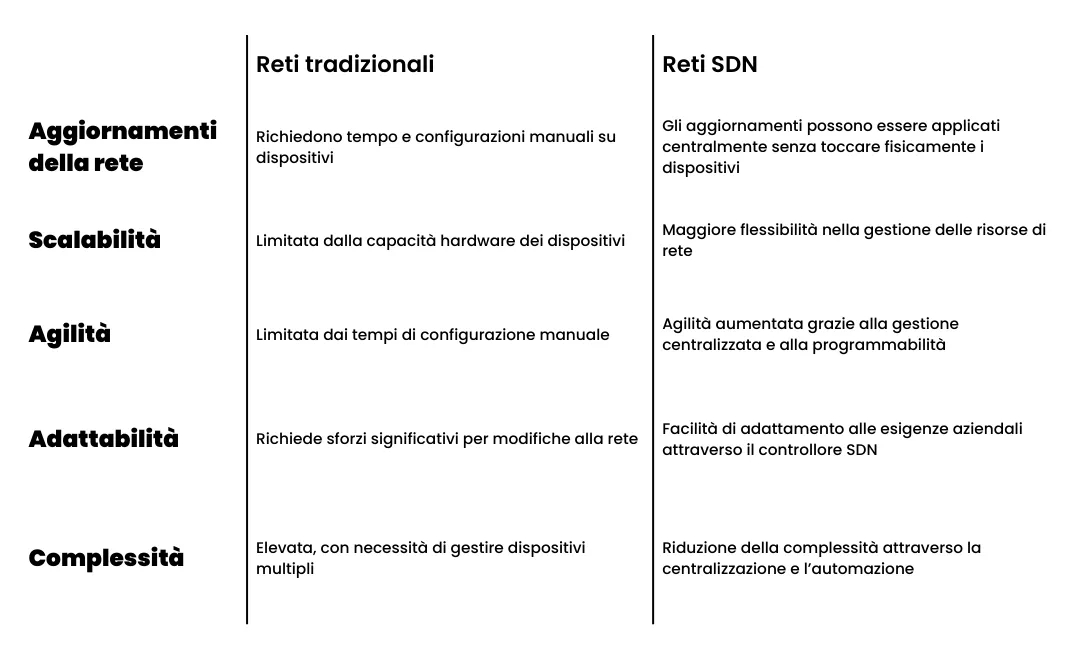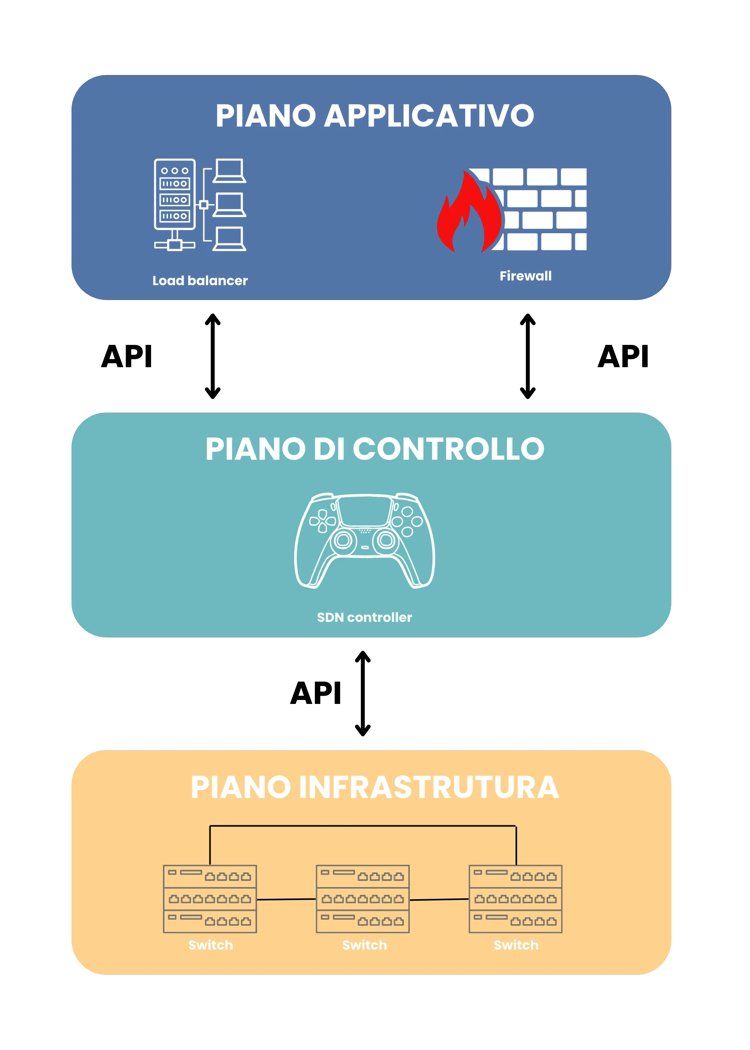Guide to Software-Defined Networking (SDN)
Tiziano Barbari - 2023-09-01
Learn about Software-Defined Networking (SDN): an innovative network architecture for agility, automation and security.
The Software-defined networks (Software-Defined Networking, hereafter SDN) represent an alternative to the traditional approach to designing, managing and deploying enterprise networks. SDN Networks unlock a new level of agility, automation and performance in digital infrastructure.
In this article, we will explore the concept of SDN, its rationale, the benefits it can offer, and the challenges associated with its implementation. We will also examine the main security aspects of SDN networks and the future prospects of this technology.
Index
- Introduction to Software-Defined Networking
- How Software-Defined Networking Works
- Challenges for Software-Defined Networking
- Security in SDN
- Use Cases of Software-Defined Networking
- Conclusions and future prospects of the SDN
Introduction to Software-Defined Networking
Software-defined networking (SDN) is much more than just an evolution of traditional networks. In the latter it was switches and routers that handled both control and data transfer. SDN is an approach to network architecture that breaks with traditional conventions. In short, instead of relying on physical hardware to control the flow of data, SDN offers a solution to move the management to a centralized layer.
In the control plane, a software program, called controller or orchestrator, makes dynamic decisions based on a global view of the network.
The SDN Orchestrator: a new control paradigm
L'orchestrator o SDN controller, separates the control plane and the data transfer plan. The former, responsible for management and network operations the latter, on the other hand, deals with packet routing and actual data transfer.
This separation offers greater greater flexibility and programmability of the network, with the SDN controller coordinating network operations like an orchestra conductor guides each individual instrument masterfully to create a harmonious symphony of connectivity.
A comparison of traditional and SDN networks
A first major difference consists in thenetwork infrastructure. Traditional networking relies on dedicated hardware devices and therefore requires manual configurations on each device.
In addition, control and data planes can be managed with the same hardware. This greatly limits the scalability, agility, and adaptability of network resources; instead, it increases complexity and possibly latency times.
L'SDN, on the other hand, virtualizes the network components and manages control through central software, the orchestrator. In doing so, it improves the programmability and visibility of the network. Also crucial is the separation of the layers by software, which makes the network more efficient and scalable.
We can visualize in a table below some of the main differences between traditional and SDN networks.
Traditional networks vs. SDN networks
How Software-Defined Networking Works
Infrastructure SDN introduces three layers (or layers) in order to better manage network. In the following image we can see a simplified representation of the architecture of SDN networks consisting of three layers, which communicate with each other in specific ways with APIs. Of course, each layer has precise tasks, let's see them together:
SDN network architecture
- Application Plan.This is the "highest" plane, involving the applications and services that exploit the network. Thus, from this plane come requests and instructions, which the SDN orchestrator takes over and manages.
- Control plane.The SDN controller, or orchestrator, is the center of the architecture: it centralizes network management, has a comprehensive view, and makes dynamic decisions. This plane receives requests from the top (via northbound APIs) and organizes the coordination and management of network operations, ensuring (via southbound APIs) that each network device acts in the correct way.
- Infrastructure or data plan.This plan is concerned with the actual transfer of data. Programmable network elements (swicth, routers...) follow the instructions of the SDN controller.
Benefits of Transitioning to Software-Defined Networking
Some of the main reasons for adopting the SDN approach may be as follows:
- Agility, scalability, efficiency:SDN offers the ability to quickly adapt the network configuration to specific needs by simply acting on a single point (the controller) instead of individual devices.
- Automation of configuration processes:Automation, centralized management and programmability greatly reduce the workload of administrators.
- Reduced operating and maintenance costs:Centralization of control eliminates the need for specialized devices, reducing operating costs and simplifying diagnosis.
Challenges of Software-Defined Networking
Despite the many benefits of SDN, there are also challenges and problems that deserve attention:
- New skills needed: SDN management requires specialized skills, requiring training for staff.
- Integration with existing systems: Integration with pre-existing systems can be complex and require significant effort.
- Increased latency: Making the hardware structure more sophisticated can have the effect of slowing down interactions between the central controller and other network components.
- New points of attack: SDN architecture introduces new vulnerabilities that require appropriate security measures to protect the network from external threats.
Let's look together at some security issues!
Security in the SDN
Security is a critical aspect in networks. In addition to traditional attacks, the following may emerge in SDN new points of vulnerability, due to the centralization of control and programmability of the network.
In fact, the central controller becomes an extremely sensitive point and, in the event of an attack, the entire network would be compromised: due to programmability, it would be possible to reconfigure network elements, damage services, and redirect traffic to unauthorized destinations. This would cause, for example, delays in services and loss (or theft) of data.
I potential attacks that the orchestrator and programmable switches can suffer are many; we could roughly divide them up by thinking about the network layers they affect:
Application Plan: App manipulation (exploiting application vulnerabilities)
Control Plan: Network manipulation (when the controller)
Data Plan: Traffic diversion, attack side channel, ARP Spoofing attack
All Plans: Denial of Service (DoS and DDoS), API explloitaion, traffic sniffing
The solution? In general, the orchestrator should not be a single point of failure, i.e., a network element whose absence or failure compromises the entire systema; instead, it should take advantage of redundant hardware, i.e., backup hardware that comes into play as soon as the primary one has some failure.
A secure password is often a key component in protecting against many of these attacks, but overall security also involves other measures, such as regularly updating systems, implementing strong encryption, implementing a segmentation appropriate network (to limit the lateral movement of any attacks and isolate different portions of the network), mechanisms for incident detection in real time, and a well-defined incident response plan for timely interventions.
Use Cases of Software-Defined Networking
The implementation of SDN has led to significant improvements in several contexts. For example, many companies have adopted SDN to improve the agility and scalability of their networks, enabling rapid configuration of new virtual networks and efficient management of network resources.
Data centers have also benefited from SDN, with increased automation allowing them to quickly adapt to changes in workload and optimize the distribution of network resources.
SDN, in fact, is used in different areas by various actors:
- The big cloud providers have adopted SDN to improve their platforms, and some solutions have been made open source.
- Enterprises are beginning to adopt SDN, often leveraging edge management services offered by cloud providers.
- The virtualization of networks was one of the first use cases for SDN, enabling the programmable creation of Virtual Private Networks (VPNs) and Virtual Local Area Networks (VLANs) for enterprise networks.
- La Software-Defined Wide-Area Network (SD-WAN) is now a practical alternative to traditional WAN services provided by telecommunications companies, simplifying the configuration of corporate VPN networks and optimizing the routing of traffic between corporate locations and cloud services.
- SDN enables the implementation of thein-band network telemetry (INT), which allows the collection of detailed information about the state of the network during packet processing. This provides an in-depth view of traffic patterns and causes of network failures, enabling deeper analysis and improvements in network performance.
Real application of SDN networks
In 2010, theStanford University undertook a migration of its campus network toward the deployment of OpenFlow: one reason was to explore SDN through innovative experiments and to understand OpenFlow as a technology actually usable by the community.
NTT DATA has devoted significant efforts in the development of SDN technologies and has developed a virtual network controller, based on NetworkOS and NOS-Application, to simplify network customization and coordination with other management solutions.
Conclusions and future prospects of the SDN
SDN offers enormous promise in network management and deployment due to its flexibility, simplification and cost reduction. However, it is critical to address the challenges and carefully consider the security aspects.
In the future, SDN will continue to evolve and be increasingly adopted; integration with emerging technologies such asartificial intelligence (AI) and theInternet of Things (IoT) could lead to even more intelligent and automated networks.
Tiziano Barbari
The author of this article has been working at Ulixe since 2021 as an SDN developer with Java stack. He has a degree in Mathematics and loves competitive programming, HPC, Machine Learning and robotics.
Back to our blog for more content from the IT world!
See More Posts
Get in touch
Ulixe Group S.r.l. Copyright © Ulixe Group S.r.l. | Lungo Dora Pietro Colletta, 67, 10153, Turin, Italy | VAT IT03305250122 | Rea Number TO1173020






